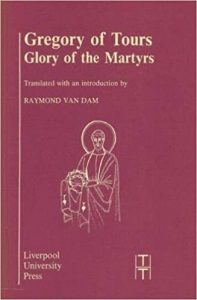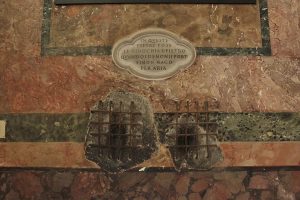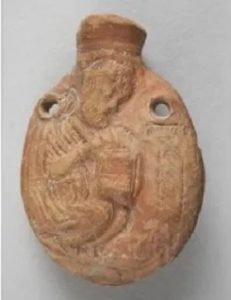Apocryphal Traditions in Gregory of Tours’ Glory of the Martyrs
I’ve spent the better part of the past two months polishing up my paper for the published proceedings of the Material of Christian Apocrypha conference that took place at the University of Virginia back in December 2018 (summary HERE and HERE). The paper is called “What They Brought Back Home: Pilgrimage Souvenirs as Transmitters of Christian Apocrypha.” From late antiquity and through the medieval period, pilgrims journeyed to various sacred sites—some of which are based purely on apocryphal traditions—and would hear stories associated with the saint and/or the site, see and touch its architectural and decorative features, participate in some kind of veneration, purchase one or more souvenirs (a token, a medal, or an ampulla, perhaps even a copy of text), and return home. There they might tell (or boast) about their experience and even proudly display their souvenirs.
 Some pilgrims wrote about their experiences, and plenty of these pilgrimage itineraries survive today, including Egeria and the Piacenza Pilgrim. One writer on pilgrimage who is frequently passed over in discussions of pilgrimage is Gregory of Tours (ca. 538–594 CE). Gregory is best known in our field as the (likely) author of an epitome of the Acts of Andrew, offering us vital information for what the original text, now mostly lost, contained. Gregory also wrote seven books relating stories of saints and miracles that they or their relics performed. One of these books is the Glory of the Martyrs (English trans. Raymond van Dan, Gregory of Tours: Glory of the Martyrs [Liverpool: Liverpool University Press, 1988]) which is written like a first-hand account of visiting the sites associated with the saints, though some of the stories and descriptions were collected by Gregory from other travelers. The text focuses principally on local martyrs of the Roman persecutions, but much of its first 35 books feature first-century characters.
Some pilgrims wrote about their experiences, and plenty of these pilgrimage itineraries survive today, including Egeria and the Piacenza Pilgrim. One writer on pilgrimage who is frequently passed over in discussions of pilgrimage is Gregory of Tours (ca. 538–594 CE). Gregory is best known in our field as the (likely) author of an epitome of the Acts of Andrew, offering us vital information for what the original text, now mostly lost, contained. Gregory also wrote seven books relating stories of saints and miracles that they or their relics performed. One of these books is the Glory of the Martyrs (English trans. Raymond van Dan, Gregory of Tours: Glory of the Martyrs [Liverpool: Liverpool University Press, 1988]) which is written like a first-hand account of visiting the sites associated with the saints, though some of the stories and descriptions were collected by Gregory from other travelers. The text focuses principally on local martyrs of the Roman persecutions, but much of its first 35 books feature first-century characters.
Gregory is a prime example of the pilgrimage experience described above—of visiting a holy site and bringing something back home to remember the journey. Most important for my purposes, however, is that Gregory’s account features a number of references to apocryphal texts and traditions.
Apocrypha and Holy Sites
In a run of ten chapters (Glor. mart. 26–35) Gregory tells the martyrdom stories of various early Christian figures and mentions the locations of their tombs. The first of these figures is James, the brother of Jesus (26), whose tomb is said to be located on the Mount of Olives alongside those of Zechariah and Simeon. Likely this is a reference to Absalom’s Tomb in the Kidron Valley which was repurposed for the three Christian martyrs in the fourth century. Gregory gives a brief account of James’s martyrdom as told by Hegesippus and Clement of Alexandria (preserved in Eusebius, Eccl. hist. 2.23) and repeated in the Passion of James from the Apostolic Histories collection, and other texts.
Gregory then moves on to the apostle Peter (27), who he introduces by saying, “In order to demonstrate humility the apostle Peter ordered that his head be tonsured.” This is the earliest reference to the tradition that Peter inaugurated the practice of cutting one’s hair in the shape of a crown. Another form of tonsure—a cut from ear to ear, known as the “Insular (or Celtic) tonsure”—was condemned at the Fourth Council of Toledo in 633 CE on the grounds that it originated with Simon Magus (on this topic, see David L. Eastman, The Ancient Martyrdom Accounts of Peter and Paul [WGRW 39; Atlanta: SBL Press, 2015], p. 441 n. 106). Gregory goes on to say more about the infamous heretic:
An oration by Peter and Paul exposed and refuted the cunning of Simon Magus. Still today at Rome there are two small indentations in the stone upon which the blessed apostles knelt and delivered their oration to the Lord against that Simon Magus. When rain water has collected in these indentations, ill people gather it; once they drink it, it soon restores their health.

Simon is a frequent sparring partner of Peter in apocryphal texts, but there are elements of Gregory’s discussion that indicates affinities with the Passion of Peter from the Apostolic Histories—including Peter’s request to be crucified upside down and his burial in the church called the Vatican. The indentations made in the stone are located, and can be seen still, in the Santa Francesca Romana (moved from their original location in the Santa Maria Nova) in the Forum below the Capitoline Hill. The next chapter gives a brief statement about the death of Paul: “The Apostle Paul was struck with a sword and died at Rome one year later but on the same day that the apostle Peter had suffered. Milk and water flowed from the holy body” (28). These details are found in another text from the Apostolic Histories: the Passion of Paul. Gregory makes no mention of a tomb for Paul, and ancient sources locate his relics in several places in Rome (either on the Ostian Road, the Laurentian Road, or the Appian Road).
Next comes John, Son of Zebedee, whose missionary activity is traditionally located in Ephesus (29), based initially on Eusebius (Hist. eccl. 3.39) and expanded into the Acts of John by Prochorus and the Syriac History of John. Of the many sites that commemorate John’s activity in the city, Gregory mentions the house where he wrote the Gospel and his tomb. According to the earlier Acts of John, the apostle did not die a martyr’s death; instead his disciples dug a trench for him and he simply laid down in it. Additions to the text state that on the following day, only John’s sandals could be found and the earth was “pouring out.” The Latin Acts of John from the Apostolic Histories and the Passion of John by Pseudo-Melito of Laodicea explicitly call the substance manna. But the earliest testimony to this phenomenon is Augustine who refers to this story in his mention of celebrations of John that took place at the tomb as early as the fifth century:
But let any one who so lists still refuse his assent, and declare that what John asserts is true enough, that the Lord said not that that disciple dies not, and yet that this is the meaning of such words as He is here recorded to have used; and further assert that the Apostle John is still living, and maintain that he is sleeping rather than lying dead in his tomb at Ephesus. Let him employ as an argument the current report that there the earth is in sensible commotion, and presents a kind of heaving appearance, and assert whether it be steadfastly or obstinately that this is occasioned by his breathing. . . . Of whom we have also the tradition (which is found in certain apocryphal scriptures), that he was present, in good health, when he ordered a sepulchre to be made for him; and that, when it was dug and prepared with all possible care, he laid himself down there as in a bed, and became immediately defunct: yet as those think who so understand these words of the Lord, not really defunct, but only lying like one in such a condition; and, while accounted dead, was actually buried when asleep, and that he will so remain till the coming of Christ, making known meanwhile the fact of his life by the bubbling up of the dust, which is believed to be forced by the breath of the sleeper to ascend from the depths to the surface of the grave. I think it quite superfluous to contend with such an opinion. For those may see for themselves who know the locality whether the ground there does or suffers what is said regarding it, because, in truth, we too have heard of it from those who are not altogether unreliable witnesses. (Tract Ev. Jo. 124.2; trans. John Gibb and James Innes, “St. Augustine: Lectures or Tractates on the Gospel According to St. John,” in A Select Library of the Nicene and Post-Nicene Fathers of the Christian Church: First Series [ed. Philip Schaff; 14 vols.; Edinburgh: T&T Clark, 1886–1890], 7:1–452).

Gregory too had knowledge of this practice: “[John the Evangelist] . . . descended into a tomb while he was still alive and ordered that he be covered in the ground. Still today his tomb produces manna with the appearance of flour; blessed relics of this manna are sent throughout the entire world and perform cures for ill people” (Glor. mart. 29). These “blessed relics” that contained the manna are likely the ampullae that have been found in various sites near Ephesus. Some of these ampullae depict a scene of a seated man writing; scholars have identified the man as John, though it may instead be John’s disciple Prochorus. Also located in Ephesus is the tomb of the Seven Sleepers (whose story is told in Glor. mart. 94) and the body of Mary Magdalene, which was later translated to Constantinople. Gregory mentions both of these in passing. “Manna” flows also out of the tomb of Andrew (30), located in Patras, Gregory says, “where the blessed apostle and martyr was crucified” as in the Acts of Andrew.
Gregory mentions two burial sites associated with Thomas, one in India (31), and the other in Edessa (32), where Thomas’s body was “much later” transferred. Gregory says the traditions about Thomas in India come from “the history of [Thomas’s] suffering” (likely meaning his martyrdom from the Acts of Thomas) though he also credits information about the monastery built over the site of Thomas’s martyrdom to a certain Theodorus “who visited the spot.” Stephen’s relics are mentioned next (33), and here Gregory relates his own work in renovating the oratory near Tours made in his name; he even donated to the site some relics of Stephen from his own collection. Bartholomew (34) is said to have been martyred in Asia, though several competing apocryphal accounts place his death in other locations (Armenia, Nindos). According to Gregory, “The pagans saw that everyone rushed to the tomb of Bartholomew and regularly offered prayers and incense. Blinded by jealousy, the pagans stole his body and put it in a sarcophagus made of lead. As they threw the sarcophagus into the sea, they said: ‘No longer will you mislead the people.’” The sarcophagus comes to rest on an island called Lipari (in Sicily), where the apostle’s body is interred at a large church built in his name. There is similarity here to the Coptic Martyrdom of Bartholomew, though here the apostle’s body is thrown in the sea immediately after his death, but is rescued by his followers and buried in a “good place.” Gregory ends his overview of holy sites associated with the apostles with Peter’s successor Clement (35). He says he was he was thrown into the sea with an anchor tied around his neck, a tradition found in the Martyrdom of Clement, which places his death in Crimea. No burial site is mentioned by Gregory, but legend has it that angels built an underwater temple on the site that could be visited once a year when the sea recedes. His relics were transferred to Rome in the ninth century.
New Apocryphal Traditions
Gregory recounts some apocryphal traditions that are not mentioned elsewhere. In his first chapter, Gregory discusses a site in Bethlehem where Mary drew water. This sounds familiar as the well of the annunciation mentioned in the Protevangelium of James, but here, as in Luke, the annunciation takes place in Nazareth not Bethlehem, and is still commemorated in Nazareth today as Mary’s Well, situated near the Greek Orthodox Church of the Annunciation. Gregory mentions how some visitors to the spring see the star that appeared to the Magi move from one wall to the opposite wall. On Mary, Gregory also discusses the tradition of her Dormition:
Although the blessed Mary had already been called [to live apart] from this world, finally the passage of her life was completed, and all the apostles gathered from their particular regions at her house. When they heard that she must be taken from the world, they all kept watch with her. And behold, the Lord Jesus came with his angels, and after taking her soul he gave it to the angel Michael and left. At dawn the apostles lifted her body on a bed, placed it in a tomb, and kept guard over it, in anticipation of the arrival of the Lord. And behold, again the Lord approached them. He took the holy body in a cloud and ordered it to be brought to Paradise, where, after regaining her soul, Mary now rejoices with his elect and enjoys the goodness of eternity that will never perish. (Glor. mart. 4)
This précis is not new to modern readers—the Dormition is extant in numerous forms and was frequently incorporated into sermons—but it was new for Gregory, who provides perhaps the earliest formulation of the doctrine in the West.
Also new is a story of a woman from Bazas who witnessed the death of John the Baptist:
John the Baptist was in fact kept in prison because [king] Herod was tricked by Herodias, is brother’s wife. At that time a woman had departed from Gaul to Jerusalem in the hope that she might deserve [to enjoy] the presence of our Lord and Savior. But she heard that the blessed John was to be beheaded. Quickly she went there, and with bribes she begged the executioner that he not deny her permission to collect the dripping blood. As the executioner struck, the woman held ready a silver vessel and piously collected some blood after the head of the martyr had been cut off. After carefully storing the blood in a flask, she brought it to her homeland. Once a cathedral had been constructed in his honor at Bazas, she placed the flask in the holy altar. (Glor. mart. 11)
The story doubtless was invented as authentication for the relic in the shrine at Bazas but it is interesting that the character was inserted into the canonical narrative in order to make this happen.
* * *
The goal of my paper is to present information about the use of apocryphal traditions in pilgrimage experience. Gregory tells us much about that experience. He doesn’t say much, however, about acquiring pilgrimage souvenirs at the sites he visits but he does mention their use, and in positive ways. Along with the ampullae of John and Andrew, Gregory describes the practice of pilgrims wrapping cords around the column at which Christ was scourged, and these cords are said to be efficacious for healing (6). At Jesus’ tomb, he says, water is sprinkled on the ground and from the dirt and water is made tokens, which are effective not only for healing but also to ward off snakes. Given Gregory’s interest in relics, and references he makes to his relics in his possession, it would be no surprise if he also collected souvenirs.
It is my hope that readers of my paper (and this post) will think more of the interplay of apocryphal texts and pilgrimage—every mention of a character’s movement from one place to another, of places they stood, of objects they touched, and the circumstances of their death is a possible reference to a holy site known to the author, or provided inspiration to others to create a holy site that allows Christians the opportunity to share the experience of the saint commemorated there. The Material of Christian Apocrypha proceedings are edited by Janet Spittler and should appear in 2022.
